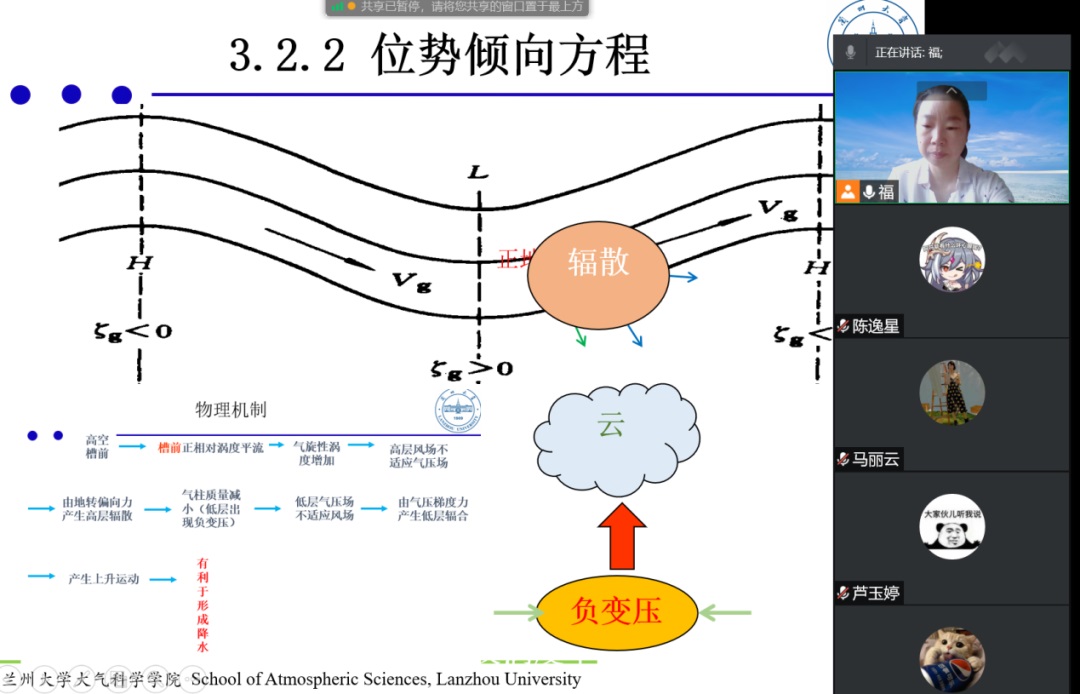Facing the sudden epidemic and the severe epidemic prevention and control situation, in order to ensure the life, health and safety of all teachers and students, according to the unified deployment of the school, the College of Atmospheric Sciences of Lanzhou University, launched the online teaching work plan at the first time, and effectively carried out activities such as 'suspending classes without stopping learning and teaching 'based on the overall situation of epidemic prevention.
The quality of teaching is always 'online'. In order to visualize the obscure knowledge and make the complex formulas easy to understand, the teacher Wang Jinyan, who teaches Principles of Weather Science, makes full use of animations, flow charts and other forms to make the teaching content intuitive and clear, so that the students can have a deeper impression, better understanding of complex knowledge points.

Classmates will never 'drop the line'. The online teaching allows more students who are interested in Principles of Weather to participate. The students in the class are always over 30, and the online interaction is frequent. The teacher guides thinking, the students speak at any time, and the teacher responds in a timely manner, so that the enthusiasm of the students is gained. It also gives students an opportunity to express their own ideas. At the same time, the convenience of the network platform is used to carry out in-class tests, timely feedback of learning situation, and two-way interaction between teaching and learning.

Strengthen two-way communication on the platform. Based on this, Mr. Wang Jinyan set up a feedback platform, and through QQ, WeChat and other commonly used methods, she answered questions and solved doubts raised by students. After the course, the students actively left a message on the platform to give feedback on the course content, which included evaluation of the teacher, comments on the content of the lecture, and doubts about the knowledge.
The following is the feedback from the classmates:
This semester we have opened a course on Principles of Weather, and recently we have learned about air masses, fronts, and extratropical cyclones. During the course, I deeply felt that the previous knowledge was connected with the current course, such as the vorticity equation in dynamic meteorology, which we used in the principle of synoptic to explain some actual weather phenomena, which made me feel that we can use what we have learned. Teacher Wang Jinyan is also very amiable, serious and responsible. Before each class, she will sort out and summarize the key points of the previous class, and she always patiently answers our questions. I hope to learn more knowledge in future classes and lay a solid foundation for future study and work.
Time flies quickly, it has been four weeks since the start this semester. As one of the most important professional courses in atmospheric science, Principles of Weather has also been explained for 16 hours since the beginning of the course.
First of all, I really like Mr. Wang's teaching style. Her clear pronunciation allows us to listen carefully to the content of the lecture without distractions. Questions before the class allow us to repeatedly consolidate the key knowledge in the previous class. Questions and answers between classes allow us to better absorb the knowledge. The conclusion after the class allows us to grasp the key and difficult points of the class more clearly.
Secondly, it is also very necessary to repeatedly consolidate in spare time. As one of the subjects of postgraduate entrance examination, its importance is self-evident. Therefore, we must do our best to study this subject for the first time. Pre-class preparation, class listening, and after-class consolidation are all indispensable.
Finally, I hope that under the leadership of Mr. Wang, we can have a deeper understanding of Principles of Weather and take a step closer to our desire to explore atmospheric science. There is a long way to go, and I will go up and down to explore!
